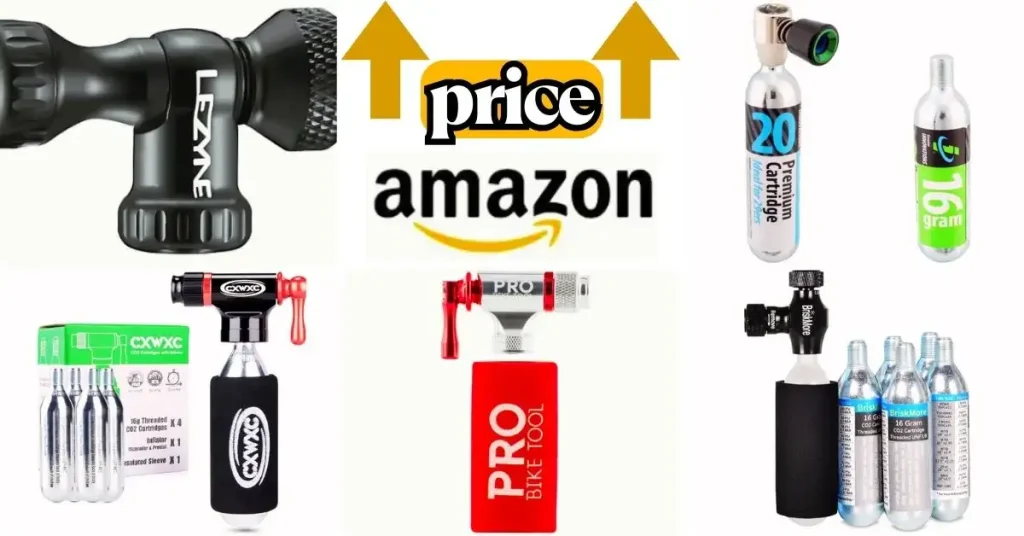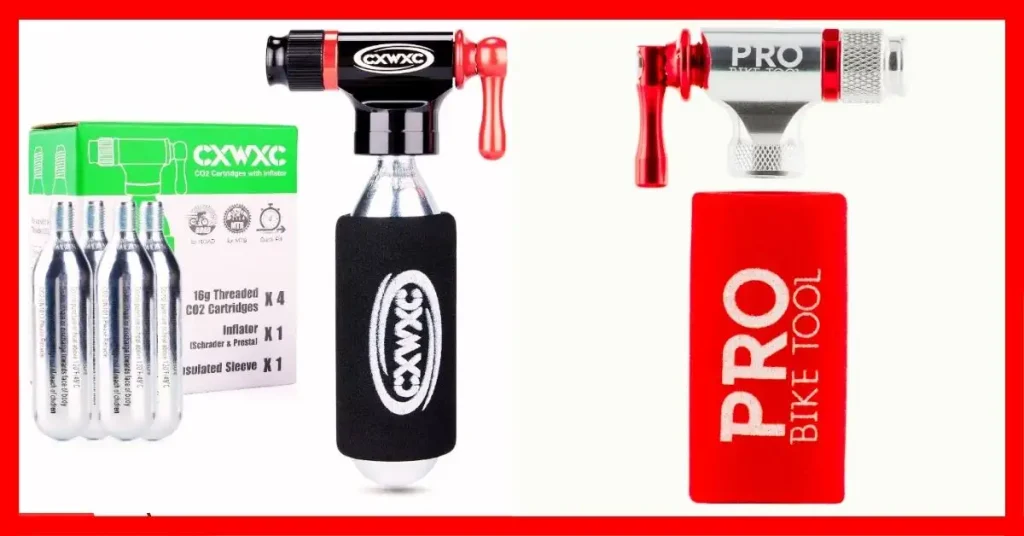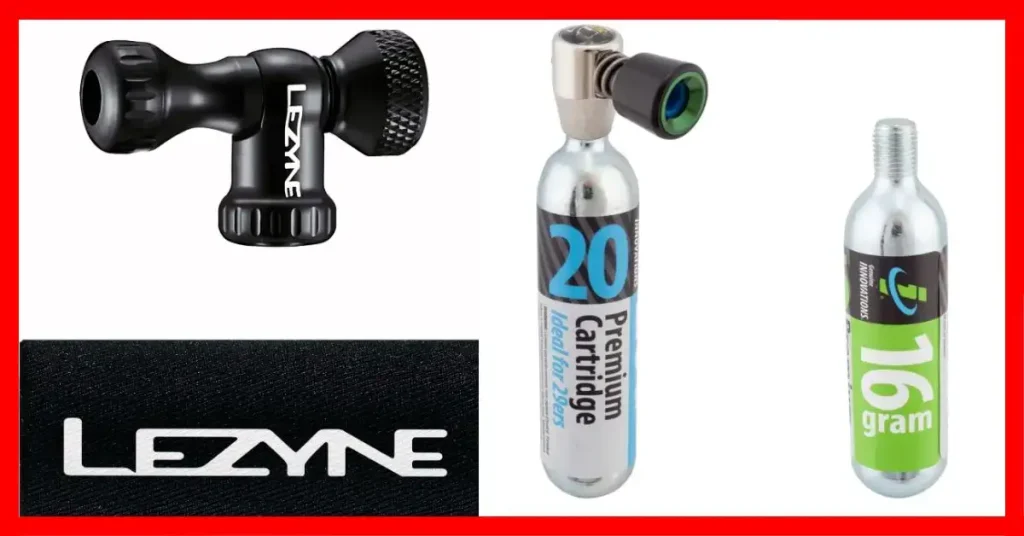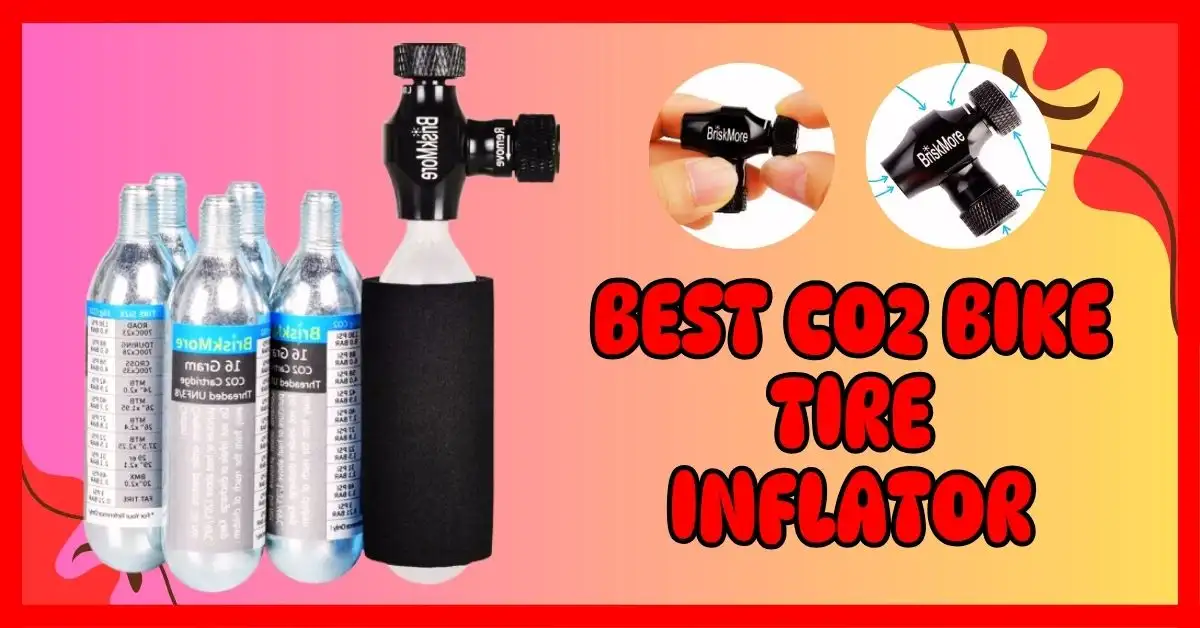I once got a flat tire on a quiet trail far from home. The air hissed out, and I thought my ride was over. Then I grabbed my CO2 bike pump, clicked in a cartridge, and in seconds the tire was full again.
That’s why I never ride without the best CO2 bike tire inflator. It’s light, fast, and easy to use when you need it most. A mini pump works too, but it’s slower and takes more effort.
In this guide, I’ll share the CO2 inflators I trust, like Pro Bike Tool and Muc-Off. You’ll see which one works best for road, MTB, or city rides. Let’s dive in so you’re never stuck on the side of the road.

What Is a CO2 Bike Tire Inflator?
A CO2 bike tire inflator is a small tool that uses gas to fill a tire fast. You screw in a cartridge, press the head, and air rushes in. It’s quick, light, and easy to carry.
Cyclists use CO2 inflators because they save time. On the road, they stop you from pumping for minutes while traffic flies by. On the trail, they mean less stress and more riding. They are built for speed and ease in tough spots.
The main difference from a mountain bike pump is how they work. A mini pump never runs out, but it takes time and effort. A CO2 inflator is instant, but each cartridge is single-use. That’s why most riders, me included, carry both.
Are CO2 Bike Pumps Good? (Quick Pros & Cons)
Yes, CO2 bike pumps are good. They shine when you need speed. A CO2 inflator fills a flat in seconds. That’s the main reason many riders carry one.
The pros are clear. They are light, small, and easy to pack. You hardly notice them until you need them. In a race or on a trail, that speed can save the day.
But there are cons too. Each cartridge is single-use. Once you fire it, it’s gone. A mini pump can keep going, but CO2 cannot. That’s why CO2 is better as a quick fix, not a full-time tool.
Think of it like a fire extinguisher. Great in an emergency, but not for daily use. I grab CO2 for races, trails, or fast rides. For longer trips, I keep a mini pump as backup. Many riders carry both for peace of mind.
How to Choose the Best CO2 Bike Tire Inflator
The right CO2 inflator makes flat fixes quick and stress-free. But not all tools are built the same. The best CO2 bike tire inflator should match your valve, your ride style, and your needs.
First, check valve type. Most road and MTB bikes use Presta valves, while some hybrids and city bikes use Schrader. Make sure your inflator fits the one you have. The wrong fit means wasted air and no fix.
Next, think about cartridge size. A 16g cartridge works fine for road bikes. For mountain bikes, you’ll want a 20–25g CO2 tyre inflator cartridge. Bigger tires need more gas, so match the size to your wheel.
Do you want a gauge? I like having one because it helps me avoid over-inflating on the road. A built-in gauge isn’t a must, but it gives peace of mind—especially for new riders who aren’t used to “feeling” tire pressure by hand.
Now, consider the design. You’ll see twist, trigger, and push inflators. Twist types are simple and cheap, but they can waste air. Trigger models give more control, which I prefer on long rides. Push types are fast, though sometimes tricky with cold hands.
Finally, think about weight. A good MTB CO2 inflator should be light and easy to pack. You don’t want extra bulk in your jersey or saddle bag. I keep mine clipped in with two spare cartridges—it feels like carrying nothing, but it’s always there when I need it.
👉🏿👉🏻 Check Latest Price and Offer at Amazon 👈🏻👈🏿
👉🏿👉🏻 Check Latest Price and Offer at Amazon 👈🏻👈🏿
👉🏿👉🏻 Check Latest Price and Offer at Amazon 👈🏻👈🏿
👉🏿👉🏻 Check Latest Price and Offer at Amazon 👈🏻👈🏿
👉🏿👉🏻 Check Latest Price and Offer at Amazon 👈🏻👈🏿

My Top Picks: Best CO2 Bike Tire Inflators
When it comes to CO2 inflators, I’ve tried a lot. Some work great, others feel tricky. These are the ones I keep coming back to—they’re fast, reliable, and easy to carry.
5.1 Pro Bike Tool CO2 Inflator
This one is my go-to. It’s small, solid, and fires every single time. I’ve used it on road rides and quick city commutes. It never lets me down. Best for road cyclists and commuters who want a no-fuss option.
5.2 Muc-Off CO2 Inflator
Muc-Off makes this inflator look good and feel durable. It has a sturdy build and a nice finish. I like using it when I want something premium in my kit. Best for riders who love high-quality gear that lasts.
5.3 PDW CO2 Inflator (Portland Design Works)
PDW’s trigger system is super easy. I love how sleek it looks and how it fits in my pack. Great for casual rides or MTB trails where speed matters. Best for casual riders and mountain bikers.
5.4 Specialized CO2 Inflator
Specialized keeps it simple and reliable. No fancy tricks, just works. I trust it because I already use Specialized gear on my bike. Best for riders who like brand consistency.
5.5 CO2 Inflator with Gauge (Generic/Popular Option)
A gauge can make a big difference. You can see the exact pressure and avoid over-inflation. I always carry this one for new riders or for MTB tires. Pair it with a CO2 tyre inflator cartridge 25g and you’re set for bigger wheels. Best for new riders or anyone who wants accuracy.

CO2 vs. MTB Mini Pump – Which Should You Carry?
If you ask me, CO2 inflators and mini pumps both have their place. CO2 inflators are fast. They get your tire back to pressure in seconds. Perfect when you’re on a trail or racing against the clock.
Mini pumps, on the other hand, are reliable and reusable. They don’t run out after one use, but pumping takes more effort and time. I always keep one as a backup, just in case I run out of CO2 cartridges.
My personal habit? I carry both. The CO2 inflator is my quick fix. The mini pump is my safety net. Together, they cover any situation—road flats, MTB trails, or city rides.
If you’re looking for recommendations, the best MTB mini pumps are small, lightweight, and fit easily in a jersey pocket or frame mount. They won’t slow you down, and they give you peace of mind for long rides.
Tips for Using a CO2 Inflator (Beginner-Friendly)
First things first: always test your CO2 inflator at home. It’s easier to learn how it works on a couch than on a muddy trail. Knowing the trigger, cartridge fit, and airflow can save a lot of stress mid-ride.
Keep spare cartridges with you. One flat can turn into a long walk if you run out. I usually stash an extra in my saddle bag—it’s lightweight and doesn’t take much space.
Store cartridges safely. After use, they get very cold, almost like ice packs. Touching them bare-handed can sting, so gloves or a cloth help. Also, never leave them in direct sun or hot cars for long periods.
Finally, use the right cartridge size for your bike. Road bikes usually need 16g, while mountain bikes often need 20–25g. Using the right size avoids under-inflation or blown tubes.
With these tips, a CO2 inflator isn’t scary—it’s a fast, reliable tool that keeps you rolling without worry.

FAQs About CO2 Bike Tire Inflators
What is the best CO2 bike tire inflator?
The best CO2 bike tire inflator is fast and easy to use. I like the Pro Bike Tool. It is small, reliable, and works every time. You can carry it on city rides or long trails.
Are CO2 bike pumps good for MTB?
Yes. They are great in emergencies. On a mountain trail, they fill your tire in seconds. I still bring a mini pump as backup.
What size CO2 cartridge do I need for mountain bike tires?
For MTB tires, use a 20–25g cartridge. Road bikes usually need 16g. The right size fills your tire safely. Too much can risk a blowout.
Can you reuse a CO2 inflator?
Yes, the inflator itself can be reused. The CO2 cartridges are single-use. Just swap in a new cartridge each time.
Do CO2 inflators damage bike tires or tubes?
Not if used carefully. Release the CO2 slowly and steadily. Check the pressure, especially on new tires, to avoid stretching the tube.
What is the difference between a CO2 bike pump and a mini pump?
CO2 pumps are fast and light. Mini pumps are slower but reusable. I carry both. CO2 for quick fixes, mini pump for longer rides.
Final Thoughts – My Real Take
If I had to pick just one CO2 inflator, I go with the Pro Bike Tool. It is small, fast, and works every time. I use it on city rides and weekend trails. It gives peace of mind when a flat hits.
I always carry both a CO2 inflator and a mini pump. The CO2 inflator fills a tire quickly. The mini pump is there if I need more control. It’s like having a first-aid kit and a toolbox. Both help in different situations.No matter where you ride, the right inflator keeps you moving. From mountain trails to city streets, a good inflator makes sure a flat does not stop your ride.
To Get More About Sports & Outdoors Product You Can Visit Our Site. If You Found our Posts Helpful Leave a Comment Below

